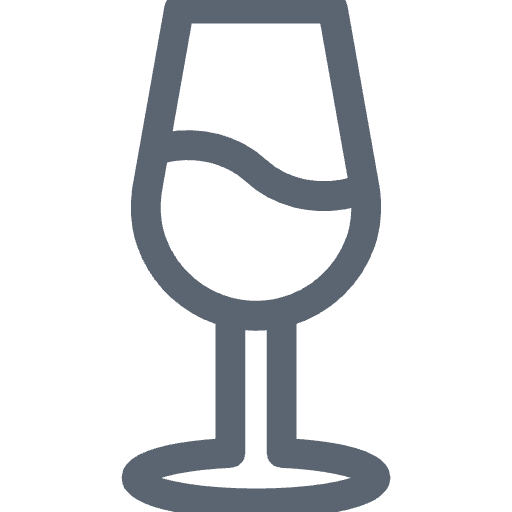About wines from the Moselle
Between Trier and Koblenz, the medium-sized Mosel wine-growing region stretches across approximately 8,000 hectares along the manifold curves of the river of the same name. Formerly known as "Mosel-Saar-Ruwer," the region's name was shortened following a 2006 amendment to the wine law, although wines from the Saar and Ruwer river banks continue to be classified under this name. Rieslings from the Mosel are renowned worldwide for their longevity and delicate balance of acidity and sweetness. Experts agree that the world's best sweet wines come from the Mosel. Despite the excellent reputation of its wines, the area under vine in the region is steadily declining, and more and more vineyards are becoming deserted and overgrown. Cultivating the extremely steep slopes (the Mosel has the steepest slopes in Europe) is hard and sometimes life-threatening work, and often unprofitable unless you own one of the prestigious and internationally sought-after grand vineyards.
Heat in summer, ice wine in winter
The steepest vineyards, almost entirely planted with Riesling, are found on the lower Moselle toward Koblenz. In the upper reaches of the river, the terrain flattens and the selection of grape varieties becomes more diverse, although the local wines are nowhere near as high as the great Rieslings. Slate soil predominates on the region's steep slopes. Slate has been used as a building material here for centuries and was sometimes subsequently added to vineyards that originally had a smaller proportion of slate in the soil. The rock is an ideal heat reservoir, ensuring that the temperature in the vineyard is maintained for longer, even in cooler air temperatures. The river at its foot reflects the sun's rays, while the steep slope of the vineyards ensures that the sun's rays hit almost vertically, thus increasing their radiance. In summer, the vineyards can sometimes become swelteringly hot, although the wind carried by the river always ensures good ventilation. Summers on the Moselle are generally hot, but the microclimate of the individual vineyards plays a decisive role. For example, there's always a risk of frost in spring and autumn, especially on the Saar and Upper Moselle, and even in mild winters, the nights are cold enough for ice wine production. However, local wild boar herds have a reputation for occasionally destroying the precious ice wine harvest around Christmas in their search for sweet snacks.
The best sweet wines in the world
Some of the vineyards in the particularly steep sections of the river are the result of deliberate dynamite blasting in the 16th century to reclaim the land, a rather risky undertaking for the wine-growing villages nestled below the slopes. Fortunately, some of the Moselle vineyards were spared the phylloxera catastrophe of 1900 and still boast ancient, ungrafted vines today. While red wine was once a major crop on the Moselle, the focus since the 19th century has been entirely on white wine, and today specifically on Riesling. These residually sweet wines are unique worldwide in their style and quality, characterized by a perfect balance of acidity and sweetness, delicate aromas of fruit and floral notes, as well as notes of wet stone and smoke. With an average alcohol content of 7-9%, they often appear only medium-dry, although the residual sugar is a respectable 30g per liter or even higher. Although dry Mosel Rieslings are increasingly gaining recognition, no other region in the world produces sweet wines that appear so light-footed and have such an irrepressible drinking flow.
That's Mosel, baby!
FAQ about Mosel wine
Is Mosel wine sweet?
Mosel wines can range in style, from dry to sweet. The region is known for its Rieslings, which can be both dry and sweet, depending on the aging and ripeness of the grapes.
Which wine comes from the Moselle?
A variety of wines come from the Mosel, but Riesling is the predominant grape variety. In addition to Riesling, other varieties such as Müller-Thurgau and Pinot Noir are also cultivated.
How much does wine cost on the Moselle?
Prices for Mosel wines vary greatly depending on the producer, vintage, quality, and style of the wine. There's a wide range from affordable to high-priced bottles.
Which wine is the best on the Moselle?
Judging the "best" wine from the Mosel depends largely on personal preference. Rieslings from renowned wineries or vineyards are often considered outstanding.
How much wine is produced on the Moselle?
The Moselle region is known for its wine production, although it is not the largest wine region. The amount varies from year to year, but it plays a significant role in German winemaking.
How is wine harvested on the Moselle?
The grape harvest on the Moselle is largely done by hand to protect the delicate grapes. The steep slopes often require manual harvesting to maintain the quality of the grapes.
Which wine from the Moselle is particularly worth trying?
There are numerous wines from the Mosel that are worth trying, depending on individual taste and preferences. Rieslings from renowned vineyards such as Bernkasteler Doctor or Wehlener Sonnenuhr are often highly regarded.
What does Mosel wine taste like?
Mosel wines, especially Rieslings, can exhibit a wide range of aromas, from fruity and floral to mineral and refreshing. The wines are often accompanied by a delicate acidity.
Which Mosel wine is the best?
Choosing the best Mosel wine is subjective and depends on individual taste preferences. Rieslings from renowned vineyards and vintages are often highly regarded.

 Moselle
Moselle  Riesling, dry
Riesling, dry complex & focused
complex & focused

 Moselle
Moselle  Riesling, dry
Riesling, dry light & fresh
light & fresh

 Moselle
Moselle  Riesling, sweet
Riesling, sweet fruity & juicy
fruity & juicy

 Moselle
Moselle  Riesling, dry
Riesling, dry fruity & smoky
fruity & smoky

 Moselle
Moselle  Riesling, semi-dry
Riesling, semi-dry sparkling & fruity
sparkling & fruity

 Moselle
Moselle  Riesling, sweet
Riesling, sweet fruity sweet & fresh
fruity sweet & fresh

 Moselle
Moselle  Riesling, sweet
Riesling, sweet fruity & juicy
fruity & juicy

 Moselle
Moselle  Riesling, sweet
Riesling, sweet complex & concentrated
complex & concentrated

 Moselle
Moselle  Riesling, sweet
Riesling, sweet dark spicy & complex
dark spicy & complex

 Moselle
Moselle  Riesling, sweet
Riesling, sweet fine & radiant
fine & radiant

 Moselle
Moselle  Riesling, dry
Riesling, dry complex & focused
complex & focused

 Moselle
Moselle  Riesling, sweet
Riesling, sweet fine & radiant
fine & radiant

 Moselle
Moselle  Riesling, sweet
Riesling, sweet fruity sweet & fresh
fruity sweet & fresh

 Moselle
Moselle  Riesling, dry
Riesling, dry complex & focused
complex & focused

 Moselle
Moselle  Riesling, sweet
Riesling, sweet fruity & juicy
fruity & juicy

 Moselle
Moselle  Riesling, dry
Riesling, dry fresh & mineral
fresh & mineral

 Moselle
Moselle  Riesling, dry
Riesling, dry complex & focused
complex & focused

 Moselle
Moselle  Riesling, sweet
Riesling, sweet complex & concentrated
complex & concentrated

 Moselle
Moselle  Riesling, dry
Riesling, dry complex & mineral
complex & mineral

 Moselle
Moselle  Riesling, dry
Riesling, dry cool & fresh
cool & fresh

 Moselle
Moselle  Riesling, sweet
Riesling, sweet full & complex
full & complex

 Moselle
Moselle  Riesling, semi-dry
Riesling, semi-dry sparkling & fruity
sparkling & fruity

 Moselle
Moselle  Riesling, dry
Riesling, dry complex & focused
complex & focused

 Moselle
Moselle  Riesling, dry
Riesling, dry complex & focused
complex & focused






















